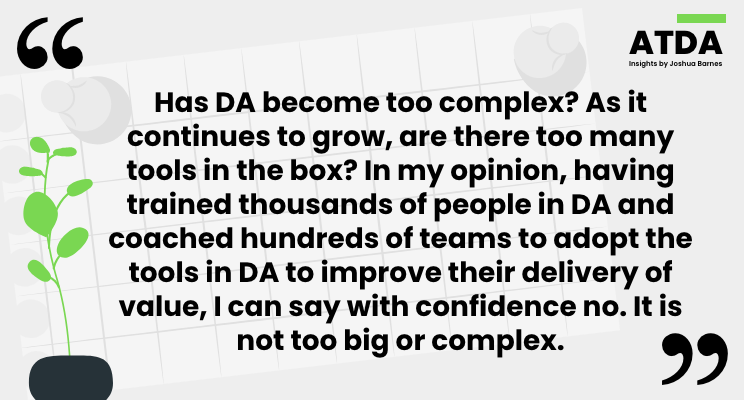
Last week I was asked to deliver a Disciplined Agile training course on short notice. Coverage was needed for the training by someone with lots of experience delivering this specific course and significant experience coaching teams to put the theory learned into action. I was happy to have been asked, my existing calendar commitments moved, and I was very excited about the opportunity.
I did not have much context on who I would be delivering the training to; I expected it was an agile team or two. Well, it turned out that I was providing this team-level course to the agile coaches of a center of excellence (CoE). Hmmm, not the level of experience I was expecting. You see, this was an evaluation of whether this course was fit for purpose for the target audience in the organization and, to some degree, whether Disciplined Agile was.
Unfortunately, some in attendance perceived Disciplined Agile as too big and felt it was complicated. There was a discussion of another approach that is much “smaller” in comparison. There is no rule you have to use all of what is in DA, quite the opposite, use what adds value and solves problems. DA awareness is growing, and I have seen this perception increase along with that growth, so I am writing this article to share my experiences.
Whether you are familiar with Disciplined Agile (“DA”) or have not even heard of it, let me share what the heart of it is, a collection of “process goals.” The creators of DA refer to this approach and body of knowledge as a tool kit. It is flexible, forming your way of working by making decisions based on goals and desired outcomes. The tools to choose from in the process goals of the DA box are agile and lean practices, techniques, and strategies.
As a tool kit, DA has a LOT of tools in it. At this point, there are over twelve hundred tools to choose from at the delivery team level. Whew, just writing that brings to mind one of those large rolling mechanics toolboxes. Would that concern you if you brought your car in for service and the mechanic had one of these big toolboxes? Would you take your car elsewhere to a mechanic who uses a toolbox filled with just a dozen tools? Or, would you think, wow, it looks like no matter what my car needs, this mechanic has a tool for it?
So why is it when a well-stocked toolbox, like the one DA provides, is filled with practices that are proven to work with agile and lean ways of working the reaction can be “it is just too big” or “we don’t need all of that, we need like 20 tools at most” or “we have to use all of those tools – no way.”
Has DA become too complex? As it continues to grow, are there too many tools in the box? In my opinion, having trained thousands of people in DA and coached hundreds of teams to adopt the tools in DA to improve their delivery of value, I can say with confidence no. It is not too big or complex.

I enjoy working on cars, and I have a sizable toolbox. I started with a modest set of starter tools at a young age. Over the last 30+ years, I have acquired many tools out of necessity and curiosity. My toolbox is similar to what a professional mechanic would have.
Out of the close to 1,000 tools I have, the majority of the time, I use only a few. For routine maintenance, I have about 30 tools I use. I can complete my work with a few wrenches, sockets, screwdrivers, pliers, etc. On occasion, I have to dip into the toolbox for a bolt or fastener that requires a different tool. This is not a problem, though. I have so many tools that I rarely need to stop what I am doing, figure out where to find the tool I need, and take the time to run out and purchase it.
When I do more extensive jobs, something such as changing the suspension components for something more sporting, I may use some of my 30 routine tools and a bunch of others for this specific work. I run into a problem; I go back to my toolbox to see what I have to solve the problem. That is the benefit of having a well-stocked toolbox.
My DA toolbox is the same. Sure, it has a lot of tools in it, but when coaching a team, they select a small number of tools to use. I don’t just spill the box over and dump 1,200 tools on the team. Instead, we look at what we need to do, go through the equivalent of drawers, and identify which tool(s) can help us. I coach teams to go to the toolbox when they do something different or encounter a challenge.
There are different models of cars. Each model’s maintenance, repairs, and enhancements can require different tools. How one mechanic approaches completing their work may differ with variations in tools used. Teams are different. Scopes of work are different. Products are different. The tools used may be different.
DA’s toolbox, filled with agile and lean practices, techniques, and strategies (the tools), is not too big or complicated. Thirty years ago, if I could have afforded to buy a fully stocked toolbox from a professional mechanic that had selected the tools, organized them in the box, and packaged it for me would have eliminated so many struggles and challenges. I would have saved countless hours, trips to the hardware store, frustration, work I would have to redo, etc.
The great thing about DA’s toolbox is that it has been curated and packaged for you, and at a price that anyone reading this newsletter can afford, it is free. Of course, you may benefit from training on selecting tools and coaching to use them, but for those who have existing agile experience, you can go right to the toolbox and explore what is in it.

We help implement lean and agile methodologies to streamline processes in a context-sensitive manner.
Quick Links
Latest Posts
All Things Value Delivery Management – Value Flow Factor 1: Small Items
Is the size of work the minimum scope to provide value a customer can consume? In most cases, the answer is no. However, whether it is a project, business case, charter, work package, epic, etc., we can almost always identify a minimum business increment. Relentless...
Project Manager to Value Delivery Manager
Here we have a common problem. The “agile team” comprises a product owner, team coach, and team members. Far too often, I hear something like, “there are no project managers in agile.” Agile teams are empowered to make decisions and determine how to get the work done....
